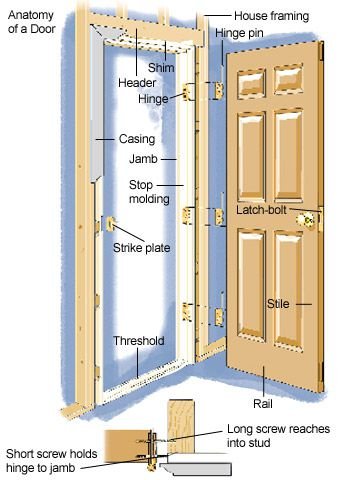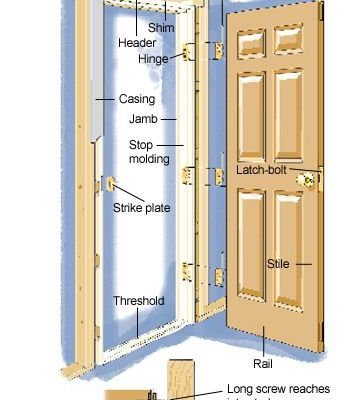
Let’s dive into the world of doors and hardware. You might be wondering how to troubleshoot issues that arise from non-standard door thickness. In this guide, I’ll help you unravel this mystery step by step. We’ll explore what you need to know about door thickness, how it affects your choices in hardware, and tips on making things work smoothly.
Understanding Door Thickness
First things first, let’s talk about door thickness. Most common doors come in standard sizes like 1 3/8 inches or 1 3/4 inches thick. But what if your door measures something different? Maybe it’s thicker or thinner than these measurements. This discrepancy can lead to a whole array of challenges when selecting hardware like locks, hinges, or handles.
Imagine trying to fit a square peg in a round hole. It just doesn’t work! When your door’s thickness doesn’t align with standard measurements, you’ll find that traditional hardware often either won’t fit at all or will function poorly. In this scenario, it’s important to measure your door accurately. Grab a tape measure and check the thickness at multiple points, if possible. This information will be crucial moving forward.
When you have the correct thickness, you can start thinking about the hardware you’ll need. While many manufacturers cater to standard sizes, others offer options for thicker or thinner doors. Knowing your door’s dimensions puts you in a much better position to find compatible hardware.
Identifying Non-Standard Thickness
What exactly qualifies as a non-standard thickness? Well, a door that’s less than 1 3/8 inches or greater than 1 3/4 inches is often considered non-standard. However, there can be variations, especially in older homes or custom builds.
To identify your door’s thickness:
- Step 1: Use a tape measure to measure the side of the door. Do this at the top, middle, and bottom for accuracy.
- Step 2: Note down the measurements. If they vary, go with the average.
- Step 3: Compare your measurements with standard thicknesses.
Once you’ve identified that your door isn’t a standard thickness, you’ll know to look for specialized hardware. This is important because trying to use standard hardware can lead to misalignment or failure to operate correctly. You want to make sure that every piece works in harmony.
Choosing the Right Hardware
Now that you know your door’s thickness, let’s explore your hardware options. If you’re dealing with a non-standard door, you’ll want to look for hardware specifically designed for varied thicknesses. Thankfully, many reputable brands offer this.
Here are some options to consider:
- Adjustable Hinges: These can accommodate different door thicknesses and can be adjusted after installation.
- Custom Locks: Some companies offer locks made for thicker doors that fit securely and operate smoothly.
- Pocket Door Hardware: If your door slides into the wall, make sure the hardware fits the door’s thickness as well.
Choosing the right hardware can significantly impact how well your door functions. For instance, you wouldn’t want to install a lock that’s too short. It might not engage properly, leading to security risks. Always check the manufacturer’s specs to ensure compatibility with your door’s dimensions.
Installing Hardware on Non-Standard Doors
Installing hardware on non-standard doors might seem intimidating, but it’s manageable with the right approach. Here’s a step-by-step guide to help you through:
1. Gather Your Tools: Before you start, make sure you have all necessary tools such as a drill, screwdrivers, and a level.
2. Mark Positions: Use a pencil to mark where the hardware will go. Double-check that your marks are level and precisely aligned with the door’s thickness.
3. Drill Holes: Gently drill at the marked spots. If you’re using specific hardware for thicker doors, make sure your holes are deep enough to accommodate them.
4. Attach Hardware: Follow the manufacturer’s instructions closely while attaching the hardware. If necessary, use spacers or shims to ensure a snug fit.
5. Test Everything: After installation, give your door a few test swings. Make sure everything operates smoothly and securely.
By taking your time and following these steps carefully, you’ll avoid common pitfalls. Remember, the goal is a functional and secure door that fits your space perfectly.
Common Problems with Non-Standard Doors
Even with careful planning, non-standard doors can still present issues. Let’s take a look at some common problems and how to solve them:
– Misalignment: If the door doesn’t align with the frame, it might not close properly. Adjust the hinges to fix this. You might need to shim them for better alignment.
– Difficulty in Locking: If the lock doesn’t engage, it could be because it’s not deep enough. Make sure you’re using a lock designed for your door’s thickness. You might need to adjust or replace it.
– Wear and Tear: Non-standard doors can sometimes lead to uneven wear on hardware. Regularly check for any signs of wear, like rust or malfunctioning parts, and replace them as needed.
By being proactive, you can extend the life of your door and its hardware. Regularly inspect everything and make adjustments to keep things running smoothly.
When to Seek Professional Help
Sometimes, the best course of action is to call in a professional. If you’re feeling overwhelmed or if your non-standard door presents complex issues, don’t hesitate to reach out for help.
Consider consulting a professional if:
– You’re Unsure: If you’re not confident in your measuring or installation skills, it might be best to let an expert handle it.
– Structural Issues: If your door frame seems warped or if there are other structural problems, a pro can assess the situation more accurately.
– Complex Hardware: If you’re looking to install intricate or high-security hardware, a professional will ensure everything is done right.
Getting help from an expert can save you time and headaches down the road. Plus, it gives you peace of mind knowing that the job is done correctly.
In summary, troubleshooting doors that are not standard thickness is a bit of a journey, but it’s one you can navigate with the right tools and knowledge. By understanding your door’s dimensions, choosing appropriate hardware, and being mindful of common issues, you can have a functional door that enhances your space. If things get tricky, remember—it’s perfectly okay to ask for help!
